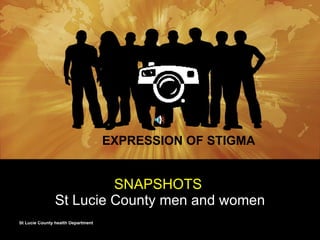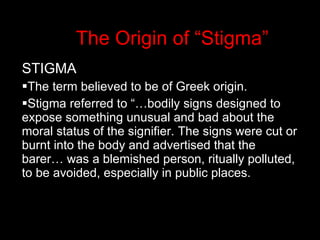Stigma Presentation
- 1. SNAPSHOTS St Lucie County men and women EXPRESSION OF STIGMA
- 2. The Origin of âStigmaâ STIGMA The term believed to be of Greek origin. Stigma referred to ââĶbodily signs designed to expose something unusual and bad about the moral status of the signifier. The signs were cut or burnt into the body and advertised that the barerâĶ was a blemished person, ritually polluted, to be avoided, especially in public places. Source: Goffman, Ervin. (1963). Stigma: Notes on the management of spoiled identity. Page 1
- 3. Community perceptions about HIV/AIDS
- 4. I FEAR, I DONâT TELL AS RESULT OF PUBLIC STIGMA It should not be donât tell we donât ask It should be tell and we support you! Fear-based stigma Value-based stigma
- 5. Living with HIV in Fear of loved ones finding out of friends abandoning you of never being held again - I donât go in the front door of services I watch who I talk too I donât try and get a job for fear of disclosure I sometimes donât want to tell SELF STIGMA
- 6. Living without HIV in Ignorance for FEAR of being labeled HIV of family knowing that I am having sex of someone knowing my business I donât inform myself, talk about it or take the test Value-based stigma
- 7. STEREOTYPES TYPECASTING LOW RISK PERCEPTION RESULTS IN
- 8. Myths and Misconceptions Fear of people living with HIV Take risks Deny I have a problem Throw the blame on others
- 9. Our RECIPEE FOR STIGMA Insufficient knowledge, misbeliefs and fears about a) how HIV is transmitted; and b) the life potential/capacity of PLHAs (no immediate death); Moral judgements about people who we assume have been sexually promiscuous Fears about death and disease Lack of recognition of stigma
- 10. RISK FACTORS Denial Unprotected sex Complacency Multiple partners Fear of test Delay in getting tested Stigma Pathway Low Risk Perception It canât happen to me COMPLACENCY I can live with HIV on MEDS
- 11. About the test Barriers Fear of getting tested Delay getting tested Lack of knowledge of testing sites Expand testing sites youth get tested at donor banks for fear of being recognized
- 12. Risk promoting and reducing behaviors of Women NO PROTECTION IT DOES NOT HAPPEN TO ME TRUST
- 13. Poverty and powerlessness render women vulnerable to infection. Disempowerment of women makes it more difficult for them to protect themselves from being infected by their partners, exposes them to sexual abuse, limits their access to knowledge about how to protect themselves, and increases the incidence of other STDs that raise susceptibility to HIV infection. This vicious circle of gender inequality, poverty and voicelessness is at the core of the relentless spread of the epidemic.
- 14. Empowerment of women Stress the importance of knowing oneâs status and the status of oneâs partner. The necessity to protect self and family. Encourage development of self-esteem and self-efficacy: issues of intimate partner/ domestic violence and gender norms. Knowledge of risk that actually exists for all women. COUNTERING HIV/AIDS STIGMA
- 15. Risk promoting and reducing behaviors of Heterosexual Men Alcohol and drugs Itâs them not me Talk to kids not me I know what I am doing Superman syndrome
- 16. WHAT SHOULD WE DO MORE OF? According to us!
- 17. Continue our Community Level Interventions Importance of involving the faith-based community (churches, synagogues, spiritual groups, etc.) in the struggle. address issues of empowerment, involvement, and dispelling threat HIV/AIDS may have on the community at large.
- 18. TURN THE NEGATIVE TO POSITIVE ALL PREVENTION IS GOOD IF IT AVERTS ONE MORE INFECTION IN OUR COMMUNITY
- 19. Create an enabling environment Make HIV/AIDS a household name Turn the negative into positive Tell everyone that TEST IS A SMART THING TO DO! Get tested at the following locations
- 20. Combat Myths about HIV Transmission not only in group intervention via other media channels
- 21. COMBAT THE FEAR BY SPEAKING OUT! People living with HIV and People that donât live with HIV
- 22. WE NEED TO GIVE THE TEST A GOOD MAKEOVER I AM NOTHING TO FEAR DO ME PLEASE I AM EASY I AM FREE I AM AVAILABLE Donât wait to do me!
- 23. HOW A journalist makes HIV/AIDS a priority in the news A doctor  debunks myths about HIV transmission and clarifies the difference between HIV and AIDS over the radio. A city council member puts HIV/AIDS on the agenda An employer speaks of the illegality of screening for HIV, the right to confidentiality of HIV status, and the value of workplace prevention programs. An HIV-positive grandmother says that people living with AIDS can live long and productive lives, given proper care and family support. An HIV-positive schoolgirl  leads a normal life, thanks to her caring family and teachers.
- 24. Address the needs of specific groups tailored Group level interventions Incarcerated men on HIV Down low
- 25. GAY COMMUNITY AND HIV
- 26. STOP THE BLAME WE ARE ALL IN THE SAME BOAT
- 27. Thank you



























